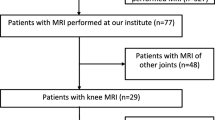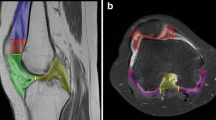Abstract
Objectives
To assess the diagnostic accuracy and reliability of MRI without contrast enhancement in the evaluation of JIA knee joint abnormalities.
Methods
JIA patients with clinically active knee involvement were prospectively studied using an 1-T open-bore magnet. MRI features were independently evaluated by two readers using the JAMRIS system. The first reading included unenhanced images, whereas complete image sets were available for the second reading.
Results
Imaging findings from 73 patients were analysed. Agreement between Gd-enhanced (+Gd) and Gd-unenhanced (−Gd) MRI scores of bone marrow changes, cartilage lesions and bone erosions was good concerning sensitivity, specificity, negative predictive value and positive predictive value. Inter-observer agreement was good for both −Gd and +Gd scores (ICC = 0.91–1.00, 0.93–1.00, respectively). Regarding the assessment of synovial hypertrophy, specificity of −Gd was high (0.97), but the sensitivity of unenhanced MRI was only 0.62. Inter-reader agreement for +Gd MRI was ICC = 0.94; however, omitting post-Gd acquisitions increased inter-reader variation (ICC = 0.86).
Conclusions
If Gd-enhanced MRI is the reference standard, omitting Gd contrast medium is irrelevant for the assessment of bone marrow changes, cartilage lesions and bone erosions as joint abnormalities in JIA. Omitting intravenous Gd in the MRI assessment of joints in JIA is inadvisable, because it decreases the reliability of detecting synovial disease.
Key Points
• Magnetic resonance imaging is increasingly used to assess juvenile idiopathic arthritis.
• Synovial hypertrophy, a marker of JIA activity, is well shown by MRI.
• Omitting intravenous contrast medium decreases the reliability of synovial hypertrophy scores.
• Bone marrow, cartilage and erosions can be reliably evaluated without contrast enhancement.
• In the evaluation of JIA disease activity, unenhanced MRI is inadvisable.





Similar content being viewed by others
References
Ravelli A, Martini A (2007) Juvenile idiopathic arthritis. Lancet 369:767–778
Petty RE, Southwood TR, Manners P et al (2004) International League of Associations for Rheumatology classification of juvenile idiopathic arthritis: second revision, Edmonton, 2001. J Rheumatol 31:390–392
Albers HM, Wessels JA, van der Straaten RJ et al (2009) Time to treatment as an important factor for the response to methotrexate in juvenile idiopathic arthritis. Arthritis Rheum 61:46–51
Vilca I, Munitis PG, Pistorio A et al (2010) Predictors of poor response to methotrexate in polyarticular-course juvenile idiopathic arthritis: analysis of the PRINTO methotrexate trial. Ann Rheum Dis 69:1479–1483
Guzman J, Burgos-Vargas R, Duarte-Salazar C, Gomez-Mora P (1995) Reliability of the articular examination in children with juvenile rheumatoid arthritis: interobserver agreement and sources of disagreement. J Rheumatol 22:2331–2336
Doria AS, Babyn PS, Feldman B (2006) A critical appraisal of radiographic scoring systems for assessment of juvenile idiopathic arthritis. Pediatr Radiol 36:759–772
Miller E, Uleryk E, Doria AS (2009) Evidence-based outcomes of studies addressing diagnostic accuracy of MRI of juvenile idiopathic arthritis. AJR Am J Roentgenol 192:1209–1218
Gylys-Morin VM, Graham TB, Blebea JS et al (2001) Knee in early juvenile rheumatoid arthritis: MR imaging findings. Radiology 220:696–706
Hemke R, van Rossum MA, van Veenendaal M et al (2012) Reliability and responsiveness of the Juvenile Arthritis MRI Scoring (JAMRIS) system for the knee. Eur Radiol. doi:10.1007/s00330-012-2684-y
Østergaard M, Peterfy C, Conaghan P et al (2003) OMERACT Rheumatoid Arthritis Magnetic Resonance Imaging Studies. Core set of MRI acquisitions, joint pathology definitions, and the OMERACT RA-MRI scoring system. J Rheumatol 30:1385–1386
Gardner-Medwin JM, Irwin G, Johnson K (2009) MRI in juvenile idiopathic arthritis and juvenile dermatomyositis. Ann N Y Acad Sci 1154:52–83
Graham TB, Laor T, Dardzinski BJ (2005) Quantitative magnetic resonance imaging of the hands and wrists of children with juvenile rheumatoid arthritis. J Rheumatol 32:1811–1820
Murray JG, Ridley NT, Mitchell N, Rooney M (1996) Juvenile chronic arthritis of the hip: value of contrast-enhanced MR imaging. Clin Radiol 51:99–102
Doria AS, de Castro CC, Kiss MH et al (2003) Inter- and intrareader variability in the interpretation of two radiographic classification systems for juvenile rheumatoid arthritis. Pediatr Radiol 33:673–681
Lamer S, Sebag GH (2000) MRI and ultrasound in children with juvenile chronic arthritis. Eur J Radiol 33:85–93
Brown AK, Quinn MA, Karim Z et al (2006) Presence of significant synovitis in rheumatoid arthritis patients with disease-modifying antirheumatic drug-induced clinical remission: evidence from an imaging study may explain structural progression. Arthritis Rheum 54:3761–3773
Nistala K, Babar J, Johnson K et al (2007) Clinical assessment and core outcome variables are poor predictors of hip arthritis diagnosed by MRI in juvenile idiopathic arthritis. Rheumatology (Oxford) 46:699–702
Hemke R, van Veenendaal M, Kuijpers TW, van Rossum MA, Maas M (2012) Increasing feasibility and patient comfort of MRI in children with juvenile idiopathic arthritis. Pediatr Radiol 42:440–448
Malattia C, Damasio MB, Basso C et al (2010) Dynamic contrast-enhanced magnetic resonance imaging in the assessment of disease activity in patients with juvenile idiopathic arthritis. Rheumatology (Oxford) 49:178–185
Workie DW, Graham TB, Laor T et al (2007) Quantitative MR characterization of disease activity in the knee in children with juvenile idiopathic arthritis: a longitudinal pilot study. Pediatr Radiol 37:535–543
van der Leij C, van de Sande MG, Lavini C, Tak PP, Maas M (2009) Rheumatoid synovial inflammation: pixel-by-pixel dynamic contrast-enhanced MR imaging time-intensity curve shape analysis—a feasibility study. Radiology 253:234–240
Axelsen M, Stoltenberg M, Poggenborg R et al. (2012) Dynamic gadolinium-enhanced magnetic resonance imaging allows accurate assessment of the synovial inflammatory activity in rheumatoid arthritis knee joints: a comparison with synovial histology. Scand J Rheumatol 41:89–94
Agarwal V, Kumar M, Singh JK, Rathore RK, Misra R, Gupta RK (2009) Diffusion tensor anisotropy magnetic resonance imaging: a new tool to assess synovial inflammation. Rheumatology (Oxford) 48:378–382
Müller LS, Avenarius D, Damasio B et al (2011) The paediatric wrist revisited: redefining MR findings in healthy children. Ann Rheum Dis 70:605–610
Jans LB, Jaremko JL, Ditchfield M, Verstraete KL (2011) Evolution of femoral condylar ossification at MR imaging: frequency and patient age distribution. Radiology 258:880–888
Acknowledgment
This work was supported by a research grant received from the Reumafonds, Dutch Arthritis Association (Amsterdam, The Netherlands). The Dutch Arthritis Association was not involved in designing and conducting this study, did not have access to the data, and was not involved in data analysis or preparation of this manuscript.
Author information
Authors and Affiliations
Corresponding author
Rights and permissions
About this article
Cite this article
Hemke, R., Kuijpers, T.W., van den Berg, J.M. et al. The diagnostic accuracy of unenhanced MRI in the assessment of joint abnormalities in juvenile idiopathic arthritis. Eur Radiol 23, 1998–2004 (2013). https://doi.org/10.1007/s00330-013-2770-9
Received:
Revised:
Accepted:
Published:
Issue Date:
DOI: https://doi.org/10.1007/s00330-013-2770-9




